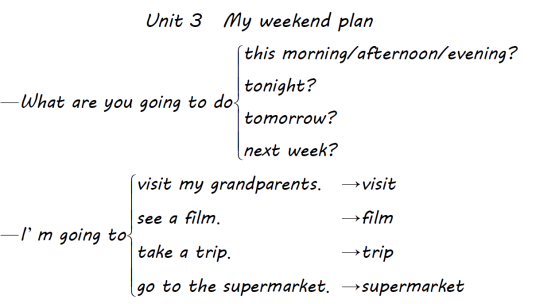人教pep六上英语 Unit 3 The second period第二课时教案
The second period(第二课时)
Part A Let’s learn & Make a plan ![]()
▶教学内容与目标
课时教学内容 | 课时教学目标 |
Let’s learn | · 能够听、说、读、写单词和词组:visit, film, trip, supermarket, evening, tonight, tomorrow, next week ·能够听、说、读、写本课重点动词词组:visit my grandparents, see a film, take a trip, go to the supermarket ·能结合本部分核心句型“—What are you going to do? —I am going to…”谈论周末计划。并能替换其中的动词词组和时间词组进行操练,做到语音准确,语调自然 |
Make a plan | ·能够根据自己的意愿在表格中写出自己的计划 ·能与同桌分享交流自己的计划内容 ·能够合理安排自己的活动时间并与他人交流重点 |
▶教学重点
1.掌握本课时的重点单词和词组。
2.能够在情景中运用含有“be going to”结构的句型谈论周末计划。
▶教学难点
1.能够在情景中运用句型“—What are you going to do? —I am going to…”谈论周末计划。并能替换其中的动词短语和时间短语进行操练,做到语音准确,语调自然。
2.能够合理安排自己的活动时间并与他人交流。
▶教学准备
PPT课件、课文录音、视频、卡片、实物、自制教具等。
 ▶教学过程
▶教学过程
1
Step 1: Warm-up & Revision & Lead-in
1. Greetings.
2. Enjoy the song of this unit—What are you going to do? (出示课件)
3. Play a game: Choose and talk.
The teacher takes out a box. There are some word cards of verbs and verb phrases in it. Play a piece of music. (出示课件) Students pass the box one by one. When the music stops, the student who holds the box chooses a card. The teacher asks, “What are you going to do?” The student tries to answer this question by using the verb or the verb phrase on the card. Make a model:
T: What are you going to do?
S1: I’m going to see a film.
…
4. Lead-in.
Show the picture of “Let’s learn” on the PPT. (课件出示:教材P25 Let’s learn板块Sarah和Chen Jie交谈的插图)
T: Who are they? What are they talking about?
Ss: They are… They are talking about…
 Encourage more students to discuss and answer these questions.
Encourage more students to discuss and answer these questions.
Step 2: Presentation
1. Learn the words and the verb phrases.
(1) Lead students to say the word “grandparents” with a picture. (出示课件) Stress that: grandma + grandpa=grandparents.
Then teach the phrase “visit my grandparents”. (课件出示:visit my grandparents的相关内容) Write down the phrase on the blackboard and lead students to practice reading it for three times.
Show one more picture of some children visiting their friend. (出示课件) Lead students to say “visit their friend”. Teach the word “visit”. (课件出示:visit的相关内容) Write down the word “visit” on the blackboard and lead students to practice reading it for three times.
(2) Show a movie poster on the PPT. (出示课件)
T: Do you know what this is?
Ss: A poster. /A movie. /A film./…
Write down the word “film” on the blackboard and lead students to practice reading it for three times. Stress that: film=movie.
Then take out a real movie ticket.
T: Look at the time on this ticket. Can you tell me when the film will start?
Ss: It will start at…
T: The film will start at 7:30 this evening. So what am I going to do this evening?
Ss: You are going to see a film.
T: You are brilliant!
Show a picture about watching a film in the cinema on the PPT. (出示课件) Write down the phrase “see a film” on the blackboard and lead students to practice reading it for three times.
(3) Take out a suitcase and pretend to go out to take a trip.
T: I like trips. Trips can make me happy. I’m going to take a trip with my friends.
Show a picture about the trip. (出示课件) Teach the word “trip”. And then show a picture of taking a trip to teach the phrase “take a trip”. (出示课件) Write down the word and the phrase on the blackboard and lead students to practice reading them for three times.
Point to the suitcase and ask: What are you going to do in your next winter vacation?
Lead students to speak out the sentence: I’m going to take a trip.
(4) Take out a shopping bag and a toy shopping cart. Ask one student to take them and walk to the teacher. There is a card in the teacher’s hand. There is a word “supermarket” on the card.
T: What is…doing? Where is he/she going?
Ss: He/ She is going shopping. He/ She is going to the…
T: Look at the word card in my hand. Now, this is a supermarket. XXX is going to the supermarket.
Show a picture of a supermarket. (出示课件) Teach the word “supermarket=super +market”. And then show a picture of a girl going shopping in the supermarket to teach the phrase “go to the supermarket”. (出示课件) Write down the word and the phrase on the blackboard and lead students to practice reading them for three times.
(5) Show the pictures of “Let’s learn”. (课件出示:教材P25 Let’s learn板块的四幅图片) Point to the four pictures one by one. Ask and answer the question with students as follow:
T: Today is Saturday. What is Chen Jie going to do this weekend?
S1: She is going to visit her grandparents.
S2: She is going to see a film.
S3: She is going to take a trip.
 S4: She is going to the supermarket.
S4: She is going to the supermarket.
2. Learn the time words and the phrases.
Show a time line of a day to teach the word and the phrases: this morning, this afternoon, this evening, tonight. Show a calendar of a month to teach the word and the phrase: tomorrow, next week. (出示课件)
 Write down the words and the phrases on the blackboard and lead students to practice reading them for two times.
Write down the words and the phrases on the blackboard and lead students to practice reading them for two times.
3. Listen, read and act.
(1)Show the pictures of “Let’s learn”. Play the recording of this part. (课件出示:教材P25 Let’s learn板块的图片和音频) Let students read the phrases and the dialogue after the recording.
(2) Act out the dialogue.
First, let students work in pairs and try to make their dialogues by using the phrases and the sentence structures in this part. Then ask several pairs to act out their dialogues.
 Step 3: Practice
Step 3: Practice
1. Listen and match.
T: Chen Jie is going to have a busy weekend. Miss X is going to have a busy weekend, too.
Make up a passage about future plans. Ask students to listen carefully and complete the matching task on the PPT.(出示课件)
2. Let’s chant.
Show a chant. The teacher and students chant together.(出示课件)
3. Boys VS Girls.
Divide students into two groups. Let boys and girls PK in this activity. Give all the word cards about time to the boys and all the word cards of verb phrases to the girls. Let them look at two pictures and fill in the dialogue “Boys: What are you going to do? Girls: I’m going to.” according to the two pictures on each PPT. The quicker group which holds up the right card will get one score. Then all the students read the dialogue in roles. Make a model:
Boys: What are you going to do this evening?
Girls: I’m going to see a film.
(补充说明:该游戏共分6个环节:第一张PPT展示的时钟上显示的时间是晚上,活动是看电影。第二张PPT展示的时钟上显示的时间是下午,活动是去超市。第三张PPT展示的时钟上显示的时间是早上,活动是洗衣服。第四张PPT展示的时钟上显示的时间是在晚上,活动是做家庭作业。第五张PPT是一个日历,上面强调显示出的时间是明天,活动是看望爷爷奶奶。最后一个PPT是一个日历,上面强调显示出的时间是下周,活动是去旅行。)
 Step 4: Consolidation & Extension
Step 4: Consolidation & Extension
“Make a plan”
1. Show the chart in “Make a plan”. (课件出示:教材P25 Make a plan板块的表格)
T: It is Saturday morning now. Make a plan and share it with your partner. You can ask and answer with each other by using the sentence structures “—What are you going to do…? —I’m/We’re going to…” Write down the answers in the chart.
Walk around to provide help when necessary.
2. Ask several pairs to show their dialogues and share their plans in the chart.
Give stickers to the students who do good jobs.
3. Show some mind maps of proper arrangement of time. (课件出示:一些合理安排时间的思维导图)
Lead students to realize the importance of arranging time reasonably.
1
▶板书设计

▶作业设计
Share your weekend plan with your parents.
▶教学反思
1.本课的设计立足于学生的实际生活, 让学生通过含有“be going to”结构的句型来交流自己的行程计划。
2.通过多种不同的方式来呈现新知,使教学灵活多变,也激发了学生的学习兴趣,活跃了课堂气氛。
3.课堂以学生为本,以解决问题为导向,引导学生自主学习。
4.在练习环节,采取了说唱、竞赛的方式,学生不仅参与度极高,同时也牢牢地把所学的知识记到了自己的脑海中,达到了在玩中学,玩中用的效果。
5.板书设计清晰明了,重点突出,起到了很好的辅助作用。![]()
▶Teaching Contents & Teaching Aims
Let’s learn
· Be able to listen, speak, read and write the words and the phrase “visit, film, trip, supermarket, evening, tonight, tomorrow, next week”.
· Be able to listen, speak, read and write the key verb phrases “visit my grandparents, see a film, take a trip, go to the supermarket”.
· Be able to use the key sentence structures “—What are you going to do? —I am going to…” to talk about the plans for the weekend. And be able to replace the verb phrases and the time phrases to practice the dialogue, to achieve accurate pronunciation and natural intonation.
Make a plan
· Be able to write their own plans in the form according to their own wishes.
· Be able to share their plans with their deskmates.
· Be able to arrange their time reasonably and communicate with others.
▶Teaching Priorities
· Master the key words and phrases of this lesson.
· Be able to talk about the plans for the weekend by using the sentence structure “be going to” in the real situations.
▶Teaching Difficulties
· Be able to use the sentence structures “—What are you going to do? —I am going to…” to talk about the plans for the weekend. And be able to replace the verb phrases and the time phrases to practice the dialogue, to achieve accurate pronunciation and natural intonation.
· Be able to arrange their time reasonably and communicate with others.
▶Teaching Procedures
Teaching Stages | Teacher’ s Activities | Students Activities | Teaching Purposes |
Warm-up & Revision & Lead-in | 1. Greetings. 2. Enjoy the song of this unit—What are you going to do? 3. Play a game: Choose and talk. 4. Lead-in. Show the picture of and ask two questions. | 1. Greetings. 2. Enjoy the song. 3. Play a game and try to answer the question by using the word cards in the box. 4. Discuss and answer the questions. | Help students review the verb phrase and the sentence structure. Activate the atmosphere of the class and stimulate students’ interest in learning. |
Presentation | 1. Learn the words and the phrasal verbs. (1) Show pictures to teach the word and the phrase. (2) Show a movie poster, a real movie ticket and a picture to teach the word and the phrase. (3) Take out a suitcase. Show pictures. Teach the word and the phrase. (4)Take out a shopping bag and a toy shopping cart. Show pictures. Teach the word and the phrase. (5) Show the pictures. | (1) Observe the pictures carefully to learn the words and the phrases. (2) Observe and feel the physical item and picture to learn the word and the phrase. (3) Watch the teacher’s action and the pictures to learn the word and the phrase. (4) Act with the teacher and observe the pictures. Learn the word and the phrase. (5) Describe Chen Jie’s weekend plan. | The key words and phrases of this lesson are taught by pictures, physical display and performance, so that the teaching of words and phrases is no longer simplex and boring. At the same time, words, phrases and sentences are integrated into one, combining with the situation, in accordance with the correct cognitive law. |
2. Learn the time words and the phrases. | Observe and learn the time words and the phrases. Practice reading the key words and the phrases. | Mark the key words and the phrases in this lesson. Help students understand and master the knowledge easily. | |
3. Listen, read and act. (1) Show the pictures. Play the recording. (2) Let students work in pairs to make dialogues and act them out. | (1) Read the phrases and the dialogue after the recording. (2) Make their dialogues and act them out. | Reading after the recording, creating dialogues and acting them out make students further understand and memorize the key content of this lesson, and develop their oral output ability. | |
Practice
| 1. Listen and match. Make up a passage about future plans. 2. Let’s chant. 3. Boys VS Girls. | 1. Listen and complete the matching task on the PPT. 2. Chant together. 3. Look at two pictures and fill in the dialogue according to the two pictures on each PPT. | Design different activities to make the practicing activities lively and interesting. Enable students to practice the substitution of verb phrases and time phrases and break through the difficulty of this lesson through the competition. |
Consolidation & Extension | “Make a plan” 1. Show the chart in “Make a plan”. 2. Ask several pairs to show their dialogues and share their plans in the chart. 3. Show some mind maps of proper arrangement of time. | 1. Ask and answer in pairs to fill in the chart in the book. 2. Show their dialogues and share their plans in the chart. 3. Realize the importance of arranging time reasonably. | Let students make their own schedule according to the knowledge. Lead students to realize the importance of reasonable arrangement of time and develop the good habit of reasonable arrangement of time. |
Homework | 1. Share your weekend plan with your parents. 2. Do the exercises. | ||
1
